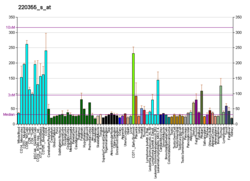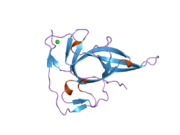Protein-coding gene in the species Homo sapiens
| PBRM1 |
|---|
|
| Available structures |
|---|
| PDB | Ortholog search: PDBe RCSB |
|---|
| List of PDB id codes |
|---|
3G0J, 3HMF, 3IU5, 3IU6, 3K2J, 3LJW, 3MB4, 3TLP, 4Q0N, 4Q0O, 4Y03, 5IID, 5FH7, 5II1, 5II2, 5FH6, 5FH8 |
|
|
| Identifiers |
|---|
| Aliases | PBRM1, BAF180, PB1, polybromo 1, SMARCH1, RCC |
|---|
| External IDs | OMIM: 606083; MGI: 1923998; HomoloGene: 10044; GeneCards: PBRM1; OMA:PBRM1 - orthologs |
|---|
| Gene location (Human) |
|---|
 | | Chr. | Chromosome 3 (human)[1] |
|---|
| | Band | 3p21.1 | Start | 52,545,352 bp[1] |
|---|
| End | 52,685,917 bp[1] |
|---|
|
| Gene location (Mouse) |
|---|
 | | Chr. | Chromosome 14 (mouse)[2] |
|---|
| | Band | 14|14 B | Start | 30,741,095 bp[2] |
|---|
| End | 30,843,549 bp[2] |
|---|
|
| RNA expression pattern |
|---|
| Bgee | | Human | Mouse (ortholog) |
|---|
| Top expressed in | - ganglionic eminence
- amniotic fluid
- sural nerve
- human penis
- saphenous vein
- Achilles tendon
- mucosa of paranasal sinus
- thymus
- epithelium of nasopharynx
- germinal epithelium
|
| | Top expressed in | - Rostral migratory stream
- Gonadal ridge
- renal corpuscle
- medullary collecting duct
- maxillary prominence
- atrium
- saccule
- mandibular prominence
- atrioventricular junction
- primitive streak
|
| | More reference expression data |
|
|---|
| BioGPS |  | | More reference expression data |
|
|---|
|
| Gene ontology |
|---|
| Molecular function | - DNA binding
- chromatin binding
- protein binding
- DNA translocase activity
| | Cellular component | - nuclear chromosome
- nucleus
- nucleoplasm
- RSC-type complex
| | Biological process | - regulation of transcription, DNA-templated
- transcription, DNA-templated
- negative regulation of cell population proliferation
- mitotic cell cycle
- chromatin remodeling
- chromatin organization
- nucleosome disassembly
- transcription elongation from RNA polymerase II promoter
| | Sources:Amigo / QuickGO |
|
| Orthologs |
|---|
| Species | Human | Mouse |
|---|
| Entrez | | |
|---|
| Ensembl | | |
|---|
| UniProt | | |
|---|
| RefSeq (mRNA) | NM_018165
NM_018313
NM_181041
NM_181042
NM_001350074
|
|---|
NM_001350075
NM_001350076
NM_001350077
NM_001350078
NM_001350079
NM_001366070
NM_001366071
NM_001366072
NM_001366073
NM_001366074
NM_001366075
NM_001366076
NM_001394867
NM_001394868
NM_001394869
NM_001394870
NM_001394871
NM_001394872
NM_001394873
NM_001394874
NM_001394875
NM_001394877
NM_001394878
NM_001394879
NM_001394880
NM_001394881
NM_001394876
NM_001400470
NM_001400471
NM_001400472
NM_001400473
NM_001400474
NM_001400475
NM_001400479
NM_001400481
NM_001400484
NM_001400487
NM_001400490
NM_001400496
NM_001400500
NM_001400501
NM_001400504 |
| NM_001081251
NM_025847
NM_001359854
NM_001359855
NM_001359856
|
|---|
NM_001359857
NM_001359858 |
|
|---|
| RefSeq (protein) | NP_060783
NP_851385
NP_001337003
NP_001337004
NP_001337005
|
|---|
NP_001337006
NP_001337007
NP_001337008
NP_001352999
NP_001353000
NP_001353001
NP_001353002
NP_001353003
NP_001353004
NP_001353005 |
| NP_001074720
NP_001346783
NP_001346784
NP_001346785
NP_001346786
|
|---|
NP_001346787 |
|
|---|
| Location (UCSC) | Chr 3: 52.55 – 52.69 Mb | Chr 14: 30.74 – 30.84 Mb |
|---|
| PubMed search | [3] | [4] |
|---|
|
| Wikidata |
| View/Edit Human | View/Edit Mouse |
|
Protein polybromo-1 (PB1) also known as BRG1-associated factor 180 (BAF180) is a protein that in humans is encoded by the PBRM1 gene.[5][6][7]
Structure and function
Human PBRM1 is one of three unique components of the SWI/SNF-B (PBAF) chromatin-remodeling complex, which contains at least SMARCA4/BRG1, SMARCB1/SNF5/INI1/BAF47, ACTL6A/BAF53A or ACTL6B/BAF53B, SMARCE1/BAF57, SMARCD1/BAF60A, SMARCD2/BAF60B, and actin.[8][9]
Chicken PB1 possesses 5 bromodomains, 2 bromo-adjacent homology (BAH) domains, and 1 truncated high-mobility group (HMG) motif. cPB1 is also homologous to yeast Rsc1, Rsc2, and Rsc4, essential proteins that are required for cell cycle progression through mitosis.[5]
Clinical significance
PBRM1 is thought to be a tumor suppressor gene in many cancer subtypes largely due to the mutational pattern.[10] Most notably, mutations and copy number alterations in PBRM1 are highly prevalent in clear cell renal cell carcinoma (ccRCC).[11]
Role renal carcinoma
Loss of function mutations in PBRM1 often co-occur with loss of function mutations in the VHL gene in clear cell renal cell carcinoma (ccRCC).[12] The inactivation of PBRM1 in combination with biallelic loss of VHL has been shown to potentiate HIF1α signaling and activate the pro-tumorigenic NF-κB pathway.[13][14] Genetic loss of PBRM1 is thought to underlie the early initiation of ccRCC due to the sufficiency of conditional deletion of Pbrm1 and Vhl for renal carcinomagenesis in mice.[15] While several studies have identified a favorable outcomes among advanced ccRCC cases with PBRM1 mutations when treated with immune checkpoint inhibitors, there is still debate about the utility of PBRM1 status as a biomarker for response to ICI therapy.[16][17]
References
- ^ a b c GRCh38: Ensembl release 89: ENSG00000163939 – Ensembl, May 2017
- ^ a b c GRCm38: Ensembl release 89: ENSMUSG00000042323 – Ensembl, May 2017
- ^ "Human PubMed Reference:". National Center for Biotechnology Information, U.S. National Library of Medicine.
- ^ "Mouse PubMed Reference:". National Center for Biotechnology Information, U.S. National Library of Medicine.
- ^ a b Xue Y, Canman JC, Lee CS, Nie Z, Yang D, Moreno GT, et al. (November 2000). "The human SWI/SNF-B chromatin-remodeling complex is related to yeast rsc and localizes at kinetochores of mitotic chromosomes". Proceedings of the National Academy of Sciences of the United States of America. 97 (24): 13015–13020. Bibcode:2000PNAS...9713015X. doi:10.1073/pnas.240208597. PMC 27170. PMID 11078522.
- ^ Yu Y, Zhang C, Zhou G, Wu S, Qu X, Wei H, et al. (August 2001). "Gene expression profiling in human fetal liver and identification of tissue- and developmental-stage-specific genes through compiled expression profiles and efficient cloning of full-length cDNAs". Genome Research. 11 (8): 1392–1403. doi:10.1101/gr.175501. PMC 311073. PMID 11483580.
- ^ "Entrez Gene: PB1 polybromo 1".
- ^ Mashtalir N, D'Avino AR, Michel BC, Luo J, Pan J, Otto JE, et al. (November 2018). "Modular Organization and Assembly of SWI/SNF Family Chromatin Remodeling Complexes". Cell. 175 (5): 1272–1288.e20. doi:10.1016/j.cell.2018.09.032. PMC 6791824. PMID 30343899.
- ^ "Q86U86 : Protein polybromo-1 (Human)". Universal Protein Resource. UniProt Consortium.
- ^ Shain AH, Pollack JR (2013). "The spectrum of SWI/SNF mutations, ubiquitous in human cancers". PLOS ONE. 8 (1): e55119. Bibcode:2013PLoSO...855119S. doi:10.1371/journal.pone.0055119. PMC 3552954. PMID 23355908.
- ^ Varela I, Tarpey P, Raine K, Huang D, Ong CK, Stephens P, et al. (January 2011). "Exome sequencing identifies frequent mutation of the SWI/SNF complex gene PBRM1 in renal carcinoma". Nature. 469 (7331): 539–542. Bibcode:2011Natur.469..539V. doi:10.1038/nature09639. PMC 3030920. PMID 21248752.
- ^ Varela I, Tarpey P, Raine K, Huang D, Ong CK, Stephens P, et al. (January 2011). "Exome sequencing identifies frequent mutation of the SWI/SNF complex gene PBRM1 in renal carcinoma". Nature. 469 (7331): 539–542. Bibcode:2011Natur.469..539V. doi:10.1038/nature09639. PMC 3030920. PMID 21248752.
- ^ Gao W, Li W, Xiao T, Liu XS, Kaelin WG (January 2017). "Inactivation of the PBRM1 tumor suppressor gene amplifies the HIF-response in VHL-/- clear cell renal carcinoma". Proceedings of the National Academy of Sciences of the United States of America. 114 (5): 1027–1032. Bibcode:2017PNAS..114.1027G. doi:10.1073/pnas.1619726114. PMC 5293026. PMID 28082722.
- ^ Yao X, Hong JH, Nargund AM, Ng MS, Heng HL, Li Z, et al. (May 2023). "PBRM1-deficient PBAF complexes target aberrant genomic loci to activate the NF-κB pathway in clear cell renal cell carcinoma". Nature Cell Biology. 25 (5): 765–777. doi:10.1038/s41556-023-01122-y. PMID 37095322. S2CID 258311941.
- ^ Gu YF, Cohn S, Christie A, McKenzie T, Wolff N, Do QN, et al. (August 2017). "Modeling Renal Cell Carcinoma in Mice: Bap1 and Pbrm1 Inactivation Drive Tumor Grade". Cancer Discovery. 7 (8): 900–917. doi:10.1158/2159-8290.CD-17-0292. PMC 5540776. PMID 28473526.
- ^ Yang Q, Shen R, Xu H, Shi X, Xu L, Zhang L, et al. (March 2021). "Comprehensive analyses of PBRM1 in multiple cancer types and its association with clinical response to immunotherapy and immune infiltrates". Annals of Translational Medicine. 9 (6): 465. doi:10.21037/atm-21-289. PMC 8039713. PMID 33850862.
- ^ Carril-Ajuria L, Santos M, Roldán-Romero JM, Rodriguez-Antona C, de Velasco G (December 2019). "Prognostic and Predictive Value of PBRM1 in Clear Cell Renal Cell Carcinoma". Cancers. 12 (1): 16. doi:10.3390/cancers12010016. PMC 7016957. PMID 31861590.
Further reading
- Martens JA, Winston F (April 2003). "Recent advances in understanding chromatin remodeling by Swi/Snf complexes". Current Opinion in Genetics & Development. 13 (2): 136–142. doi:10.1016/S0959-437X(03)00022-4. PMID 12672490.
- Suzuki H, Fukunishi Y, Kagawa I, Saito R, Oda H, Endo T, et al. (October 2001). "Protein-protein interaction panel using mouse full-length cDNAs". Genome Research. 11 (10): 1758–1765. doi:10.1101/gr.180101. PMC 311163. PMID 11591653.
- Lemon B, Inouye C, King DS, Tjian R (2002). "Selectivity of chromatin-remodelling cofactors for ligand-activated transcription". Nature. 414 (6866): 924–928. doi:10.1038/414924a. PMID 11780067. S2CID 4391100.
- Olave I, Wang W, Xue Y, Kuo A, Crabtree GR (October 2002). "Identification of a polymorphic, neuron-specific chromatin remodeling complex". Genes & Development. 16 (19): 2509–2517. doi:10.1101/gad.992102. PMC 187451. PMID 12368262.
- Horikawa I, Barrett JC (August 2002). "cDNA cloning of the human polybromo-1 gene on chromosome 3p21". DNA Sequence. 13 (4): 211–215. doi:10.1080/1042517021000021590. PMID 12487023. S2CID 23406882.
- Sekine I, Sato M, Sunaga N, Toyooka S, Peyton M, Parsons R, et al. (April 2005). "The 3p21 candidate tumor suppressor gene BAF180 is normally expressed in human lung cancer". Oncogene. 24 (16): 2735–2738. doi:10.1038/sj.onc.1207694. PMID 15735765. S2CID 19875372.
- Yan Z, Cui K, Murray DM, Ling C, Xue Y, Gerstein A, et al. (July 2005). "PBAF chromatin-remodeling complex requires a novel specificity subunit, BAF200, to regulate expression of selective interferon-responsive genes". Genes & Development. 19 (14): 1662–1667. doi:10.1101/gad.1323805. PMC 1176002. PMID 15985610.
- Tao WA, Wollscheid B, O'Brien R, Eng JK, Li XJ, Bodenmiller B, et al. (August 2005). "Quantitative phosphoproteome analysis using a dendrimer conjugation chemistry and tandem mass spectrometry". Nature Methods. 2 (8): 591–598. doi:10.1038/nmeth776. PMID 16094384. S2CID 20475874.
- Beausoleil SA, Villén J, Gerber SA, Rush J, Gygi SP (October 2006). "A probability-based approach for high-throughput protein phosphorylation analysis and site localization". Nature Biotechnology. 24 (10): 1285–1292. doi:10.1038/nbt1240. PMID 16964243. S2CID 14294292.
- Olsen JV, Blagoev B, Gnad F, Macek B, Kumar C, Mortensen P, Mann M (November 2006). "Global, in vivo, and site-specific phosphorylation dynamics in signaling networks". Cell. 127 (3): 635–648. doi:10.1016/j.cell.2006.09.026. PMID 17081983. S2CID 7827573.
- Chandrasekaran R, Thompson M (April 2007). "Polybromo-1-bromodomains bind histone H3 at specific acetyl-lysine positions". Biochemical and Biophysical Research Communications. 355 (3): 661–666. doi:10.1016/j.bbrc.2007.01.193. PMID 17320048.
 | This article on a gene on human chromosome 3 is a stub. You can help Wikipedia by expanding it. |
 1w4s: CRYSTAL STRUCTURE OF THE PROXIMAL BAH DOMAIN OF POLYBROMO
1w4s: CRYSTAL STRUCTURE OF THE PROXIMAL BAH DOMAIN OF POLYBROMO



















